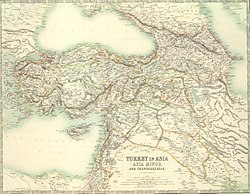Beylik of Dulkadir
Dulkadirids | |||||||||||
|---|---|---|---|---|---|---|---|---|---|---|---|
| 1337–1522 | |||||||||||
 An anachronistic map of the Anatolian beyliks in around 1330 | |||||||||||
| Capital | |||||||||||
| Religion | Islam (Sunni and Shia),[2] Christianity[3] | ||||||||||
| Government | Beylik | ||||||||||
| Beg | |||||||||||
• 1337 | Zayn al-Din Qaraja | ||||||||||
• 1522 | Ali | ||||||||||
| Historical era | Late Medieval | ||||||||||
• Established | 1337 | ||||||||||
• Disestablished | 1522 | ||||||||||
| Area | |||||||||||
| 70,000[1] km2 (27,000 sq mi) | |||||||||||
| |||||||||||
| History of Turkey |
|---|
 |
| Timeline |
|
|
The Beylik of Dulkadir (Turkish: Dulkadiroğulları Beyliği) was one of the Anatolian beyliks established by the Turkoman clans Bayat, Afshar, and Begdili after the decline of Seljuk Sultanate of Rûm.
Etymology
[edit]The meaning of Dulkadir is unclear. It was later Arabized or reinterpreted according to folk tradition as Dhu'l-Qadr, which means 'powerful' or 'mighty'.[4] According to 16th-century German historian Johannes Leunclavius, Dulkadir was a corruption of the Turkic name Torghud. Franz Babinger considered it very probable, as the name was likely derived from some Turkish name, further suggesting that this would also mean the dynasty of Dulkadir is related to the Turkoman Turghudlu tribe.[5] On the other hand, Annemarie von Gabain proposed tulga-dar (lit. 'helmet-bearer') as the original Turkic word it sprang from.[6] According to Turkologist Louis Bazin, the name may be rooted in the term "dolga," which means "to hurt" or "to agonize". Historian Faruk Sümer suggested that Dulkadir could be the Turkmen pronunciation of the Muslim given name Abdul Qadir, parallel to how the Ilkhanate ruler Abu Sa'id (r. 1316–35) was known as "Busad" by his Turkmen subjects. Another historian, Refet Yinanç, supported Sümer's view.[7]
Medieval Armenian authors referred to the Dulkadirids as Tulgharts'i, Tulgharats'i, Dulgharats'i, Tulghatarts'i, or Dulghatarts'i.[8] While Persian sources spelled Dulkadir as Zulkadir, Arabic sources spelled it as Dulgadir or Tulgadir. Ottoman sources used a combination of Zulkadir and Dulkadir.[9]
History
[edit]The principality was founded by Zayn al-Din Qaraja, a Turkoman chieftain, likely from the Bayat tribe,[10] who established himself in the region of Elbistan in 1335, taking the town in 1337 and obtaining the title of na'ib from the Mamluk Sultan Al-Nasir Muhammad. In 1515, after the Battle of Turnadağ, the principality was conquered by the Ottoman Sultan Selim I's vizier Hadım Sinan Pasha and converted into a sanjak.[11]
List of rulers
[edit]| No. | Rulers | Regin Start | Regin End |
|---|---|---|---|
| 1. | Zayn al-Din Qaraja | 1337 | 1353 |
| 2. | Ghars al-Din Khalil | 1353 | 1386 |
| 3. | Shaban Suli | 1386 | 1398 |
| 4. | Sadaqa Beg | 1398 | 1399 |
| 5. | Nasir al-Din Mehmed Beg | 1399 | 1442 |
| 6. | Suleiman Beg | 1442 | 1454 |
| 7. | Sayf al-Din Malik Arslan | 1454 | 1465 |
| 8. | Shah Budak | 1st.1465
2nd.1472 |
1st.1466
2nd.1480 |
| 9. | Shah Suwar Al-Muzaffar | 1466 | 1472 |
| 10. | Ala al-Dawla Bozkurt | 1480 | 1515 |
| 11. | Ali Beg | 1515 | 1522 |
References
[edit]- ^ a b Öztuna 2005, p. 88.
- ^ Yinanç 1989, p. 89.
- ^ Yinanç 1989, p. 81.
- ^ Bosworth 1996, pp. 238.
- ^ Babinger 2012.
- ^ Mordtmann & Ménage 2012.
- ^ Yinanç 1989, p. 7.
- ^ Sanjian 1969, pp. 433, 438.
- ^ Yinanç 1989, p. 6.
- ^ Alıç 2020, pp. 84.
- ^ Har-El 1995, pp. 40.
Bibliography
[edit]- Alıç, Samet (2020). "Memlûkler Tarafından Katledilen Dulkadir Emirleri" [The Dulkadir's Emirs Killed by the Mamluks]. The Journal of Selcuk University Social Sciences Institute (in Turkish) (43): 83–94. Retrieved 19 March 2023.
- Babinger, Franz (2012). "Ṭorg̲h̲ud-eli". In Houtsma, M. Th.; Arnold, T. W.; Basset, R.; Hartmann, R. (eds.). Encyclopaedia of Islam. Vol. I. Brill.
- Bosworth, Clifford Edmund (1996). New Islamic Dynasties: A Chronological and Genealogical Manual. Edinburgh University Press.
- Har-El, Shai (1995). Struggle for Domination in the Middle East: The Ottoman-Mamluk War, 1485-91. E.J. Brill. ISBN 9004101802. Retrieved 19 March 2023.
- Mordtmann, Johannes Heinrich & Ménage, Victor Louis (2012). "Ḏh̲u 'l-Ḳadr". Encyclopaedia of Islam New Edition Online. Leiden: E. J. Brill.
- Öztuna, Yılmaz (2005). Devletler ve hanedanlar: Türkiye (1074-1990) (in Turkish). Ministry of Culture. ISBN 9751704693. OCLC 949531568.
- Sanjian, Avedis K. (5 February 1969). Colophons of Armenian Manuscripts, 1301-1480, A Source for Middle Eastern History (PDF). Cambridge, Massachusetts: Harvard University Press. ISBN 9780674432611. OCLC 54310. Retrieved 16 February 2024.
- Venzke, Margaret L. (2017). "Dulkadir". In Fleet, Kate; Krämer, Gudrun; Matringe, Denis; Nawas, John; Rowson, Everett (eds.). Encyclopaedia of Islam (3rd ed.). Brill Online. ISSN 1873-9830.
- Yinanç, Refet (1989). Dulkadir Beyliği (in Turkish). Ankara: Turkish Historical Society Press. ISBN 9751601711. OCLC 21676736.

